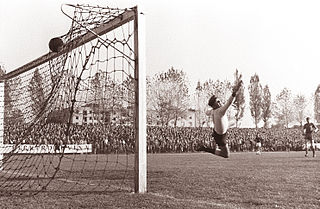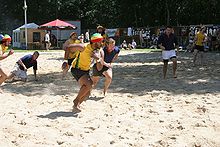
Association football, more commonly known as football or soccer, is a team sport played between two teams of 11 players each, who almost exclusively use their feet to propel a ball around a rectangular field called a pitch. The objective of the game is to score more goals than the opposing team by moving the ball beyond the goal line into a rectangular-framed goal defended by the opposing team. Traditionally, the game has been played over two 45-minute halves, for a total match time of 90 minutes. With an estimated 250 million players active in over 200 countries and territories, it is the world's most popular sport.

Gaelic football, commonly known as simply Gaelic, GAA, or football, is an Irish team sport. A form of football, it is played between two teams of 15 players on a rectangular grass pitch. The objective of the sport is to score by kicking or punching the ball into the other team's goal or between two upright posts above the goal and over a crossbar 2.5 metres above the ground.

In sport, a goal may refer to either an instance of scoring, or to the physical structure or area where an attacking team must send the ball or puck in order to score points. The structure of a goal varies from sport to sport, and one is placed at or near each end of the playing field for each team to defend. Sports which feature goal scoring are also commonly known as invasion games.
A try is a way of scoring points in rugby union and rugby league football. A try is scored by grounding the ball in the opposition's in-goal area. Rugby union and league differ slightly in defining "grounding the ball" and the "in-goal" area. In rugby union a try is worth 5 points, and in rugby league a try is worth 4 points.

International rules football is a team sport consisting of a hybrid of football codes, which was developed to facilitate international representative matches between Australian rules football players and Gaelic football players.
The Laws of the Game are the codified rules of association football. The laws mention the number of players a team should have, the game length, the size of the field and ball, the type and nature of fouls that referees may penalise, the offside law, and many other laws that define the sport. During a match, it is the task of the referee to interpret and enforce the Laws of the Game.
In rugby football, the penalty is the main disciplinary sanction available to the referee to penalise players who commit deliberate infringements. The team who did not commit the infringement are given possession of the ball and may either kick it towards touch, attempt a place kick at goal, or tap the ball with their foot and run it. It is also sometimes used as shorthand for penalty goal.

A football pitch or soccer field is the playing surface for the game of association football. Its dimensions and markings are defined by Law 1 of the Laws of the Game, "The Field of Play". The pitch is typically made of natural turf or artificial turf, although amateur and recreational teams often play on dirt fields. Artificial surfaces are allowed only to be green in colour.

Like most forms of modern football, rugby league football is played outdoors on a rectangular grass field with goals at each end that are attacked and defended by two opposing teams. The rules of rugby league have changed significantly over the decades since rugby football split into the league and union codes. This article details the modern form of the game and how it is generally played today, although rules do vary slightly between specific competitions.

A comparison of American football and rugby union is possible because of the games' shared origins, despite their dissimilarities.
A comparison between American football and rugby league is possible because of their shared origins and similar game concepts. Rugby league is arguably the most similar sport to American football after Canadian football: both sports involve the concept of a limited number of downs/tackles and scoring touchdowns/tries takes clear precedence over goal-kicking.

The team sports rugby union and rugby league share origins and thus have many similarities. Initially, following an 1895 split in rugby football, rugby union and rugby league differed in administration only. Soon, however, the rules of rugby league were modified, resulting in two distinct forms of rugby.

A drop goal, field goal, or dropped goal is a method of scoring points in rugby union and rugby league and also, rarely, in American football and Canadian football. A drop goal is scored by drop kicking the ball over the crossbar and between the posts of the goal posts. After the kick, the ball must not touch the ground before it goes over and through, although it may touch the crossbar, the uprights or an opponent. A drop goal in rugby union is worth three points, and in rugby league a drop goal is usually worth one point.
Rugby league football has accrued considerable jargon to describe aspects of the game. Many terms originate in the Laws of the Game. Some aspects of the game have more than one term referring to them. Different terms have become popularly used to describe an aspect of the game in different places, with notable differences between the Northern and Southern Hemispheres.
Football is a family of team sports that involve, to varying degrees, kicking a ball to score a goal. Unqualified, the word football generally means the form of football that is the most popular where the word is used. Sports commonly called football include association football ; Australian rules football; Gaelic football; gridiron football ; International rules football; rugby league football; and rugby union football. These various forms of football share, to varying degrees, common origins and are known as "football codes".
A comparison of Canadian football and rugby union is possible because of the games' shared origins, despite their dissimilarities.
A comparison of Canadian football and rugby league football can be made because of their shared origins, resulting in similarities and shared concepts in terms of scoring and advancing the ball. Aside from American football, rugby league is the sport most similar to Canadian football. Both sports involve the concept of a limited number of 'downs'/'tackles', and in both sports scoring 'touchdowns'/'tries' takes a clear precedence over goal-kicking.

The laws of Rugby Union are defined by World Rugby and dictate how the game should be played. They are enforced by a referee, generally with the help of two assistant referees.

A comparison of Gaelic football and rugby union is possible because of certain similarities between the codes, as well as the numerous dissimilarities.

In games of association football, teams compete to score the most goals. A goal is scored when the ball passes completely over a goal line at either end of the field of play between two centrally positioned upright goal posts 24 feet (7.32 m) apart and underneath a horizontal crossbar at a height of 8 feet (2.44 m) — this frame is itself referred to as a goal. Each team aims to score at one end of the pitch, while preventing their opponents from scoring at the other end. Nets are usually attached to the goal frame to catch goalscoring balls, but the ball is not required to touch the net.






















